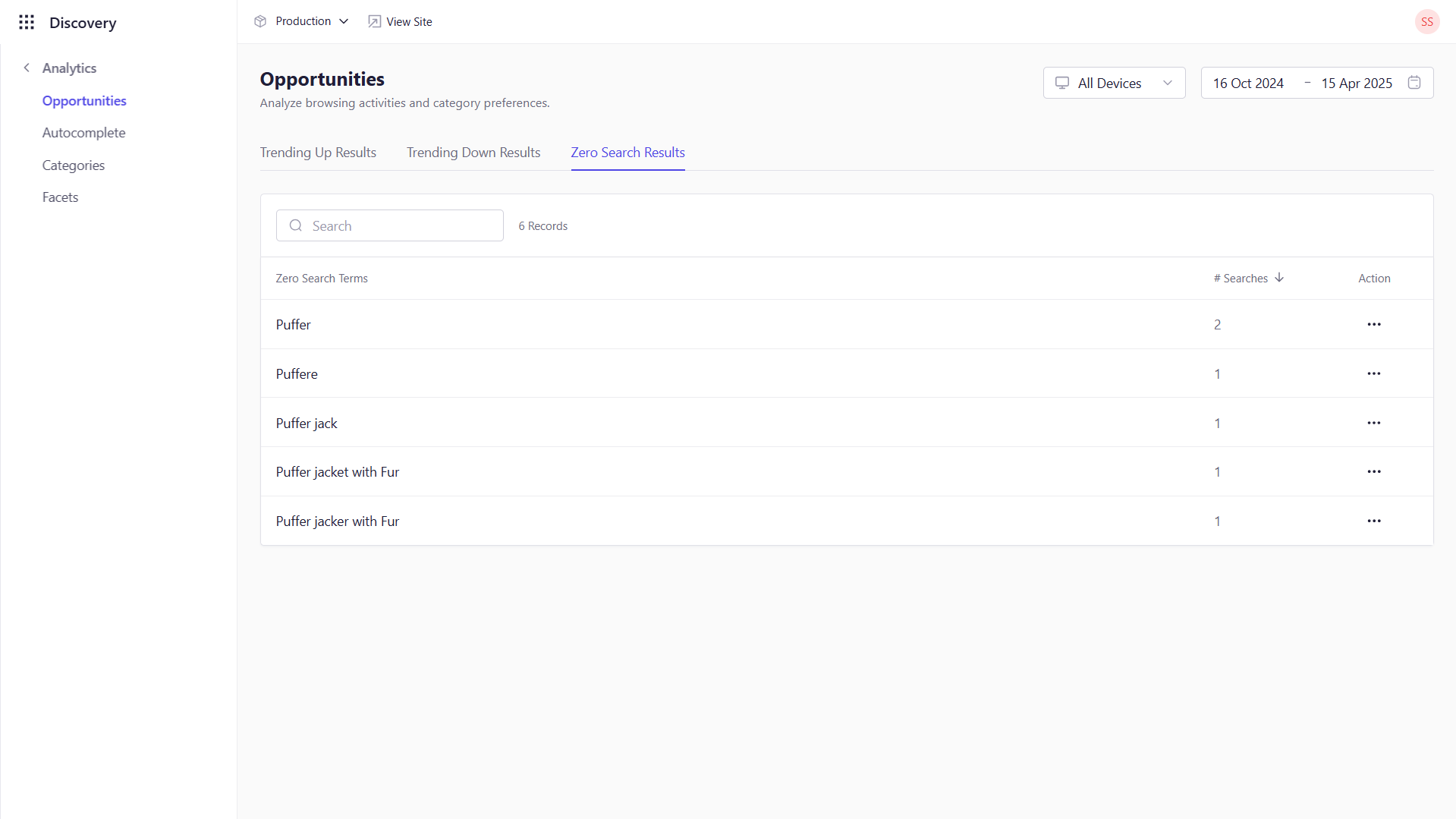Identifying Opportunities from the Dashboard
Overview
The Opportunities Dashboard organizes actionable search insights into three tabs:- Trending Up Results:
Displays search terms that are gaining popularity over your selected timeline. This tab helps you identify emerging trends so you can capitalize on new customer interests.

- Trending Down Results:
Shows search terms that are declining in popularity. These insights allow you to pinpoint potential issues or adjust strategies for keywords that are losing traction.

- Zero Search Results:
Lists search terms that return no results. This highlights gaps in your product catalog or search configuration that may need attention.

 . The available actions include:
. The available actions include:
- Try: Test the search term to view current results.
- Merchandise: Create or modify merchandising rules associated with the term.
- Add Synonyms: Enhance search relevance by adding alternative terms.
- Add Phrases: Group related words to ensure accurate search interpretation.
Step‑by‑Step Workflow
1
Access the Opportunities Dashboard
- Navigate to Discovery → Analytics → Opportunities.
- Choose the tab of interest (Trending Up, Trending Down, or Zero Results).
2
Analyze Your Data
- Trending Up: Look for spikes tied to promotions, new launches, or external events. Integrate multiple data sources (e.g., marketing campaigns, social media buzz) for context.
- Trending Down: Cross‑reference with inventory and performance metrics to pinpoint root causes—out‑of‑stock items, diminished demand, or poor display.
- Zero Results: Group similar zero‑result terms (e.g., “bamboo toothbrush,” “eco toothbrush”) to prioritize catalog expansion or synonym additions.
3
Take Action on Each Term
- Click
 next to a term.
next to a term. - Select Try to validate existing search behavior.
- Choose Merchandise to open the rule engine—set up boosts, buries, pins, or slots tailored to that query.
- Use Add Synonyms to capture related terms and Add Phrases for compound queries.
4
Validate & Iterate
- After changes, test searches to confirm improved results.
- Monitor the same tab periodically—what’s trending one week may cool off the next. Practice ongoing change management, assigning stakeholders and documenting updates.
Leveraging Data for Strategic Decisions
-
Capitalize on Emerging Trends:
Use Trending Up data to adjust promotions, update landing pages, or feature products in banners—acting quickly on what’s resonating with users. -
Address Declines Proactively:
For Trending Down terms, consider targeted remarketing, refreshed imagery/descriptions, or adjusting stock levels to reignite interest. -
Resolve Catalog Gaps:
Zero Results insights drive catalog enrichment. Add new products or configure synonyms/phrases so that searches yield at least related items—even if exact matches aren’t yet in stock. -
Holistic Dashboard Best Practices:
Keep dashboards focused on your core KPIs (e.g., search CTR, add‑to‑cart rate). Avoid clutter—start with a straightforward question (“Which search terms underperform?”) and build around that. -
Measure & Forecast:
Integrate Opportunities data with broader ecommerce analytics (revenue, traffic, inventory). Use trend analysis to forecast demand and plan inventory accordingly.